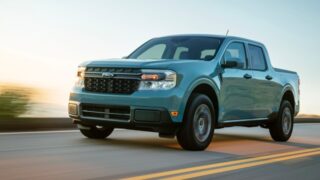New V8 6.7L Power Stroke Diesel Review: Scorpion, Turbocharger, Performance, and Features
The new Ford 6.7L Power Stroke Diesel aims to take control of the heavy duty truck market. Code named the Scorpion, the 6.7L Power Stroke Diesel is designed completely in-house by Ford engineers unlike the previous diesel engines in the F-series trucks and is packed full of innovations.
The new 6.7L Power Stroke Diesel (PSD) is expected to greatly outperform its predecessors thanks to a unique new cylinder head design and Ford’s new single sequential turbocharger. Both of these items help to increase horsepower and torque, while lowering both engine emissions and the “lag” often associated with turbocharged engines.
The cylinder head uses a reverse flow design. Most combustion engines feed exhaust gases through the bottle of the cylinder heads and through the exhaust system. The new 6.7L PSD directs it exhaust gases through the top of the cylinder heads, through short exhaust manifolds and quickly into the turbocharger housing. Once entering the turbocharger, the exhaust gases spin the hot side turbine, creating forced intake air on the cool side but unlike a “normal” turbo, Ford’s new Single Sequential Turbocharger (SST) uses twin compressor wheels on the intake side. This innovative system was designed with assistance from Garrett Turbochargers, and the SST effectively does the work of a twin turbo setup, using two nearly identical compressor wheels with individual air channels to force the air into the engine. The turbocharger is mounted to the top of the engine, with oil and water lines running to the housing to keep the unit running as cool as possible and to prevent anything from clogging up the oiling system, the front of the turbo mounting pedestal also holds a pre-turbocharger oil filter.
Once that air is compressed, it enters into the new air to water charge air cooler, helping to decrease the intake air temperature before heading into the composite polymer intake manifold. While some question using a “plastic” intake manifold, Ford found this to be the best for avoiding heat soak issues common to forced induction setups. To test the overall durability of the new engine, extensive tests were conducted in dynamometer rooms but since nothing can really bring out the perils of the real roads, a handful of “test Mules” were driven for 250,000 miles and then the new 6.7L PSD was removed and torn apart for close examination for any internal issues.
The cylinder head layout, turbocharger design, and cooling system should help to nearly eliminate all of the common “down sides” associated with diesel engines, and the overall construction of the new 6.7L Power Stroke Diesel is intended to cut down on engine noise. The 6.7L “Scorpion” could prove to not only be a great engine for the heavy duty “work trucks”, but with a diesel option still expected for the 2011 F150, this engine layout could be a look into the future of the diesel passenger truck and car market.




